
Album met landschappen en bijbelse en mythologische taferelen 1615 - 1799
0:00
0:00
drawing, paper, ink
#
drawing
#
paper
#
ink
#
coloured pencil
Dimensions: height 407 mm, width 270 mm, thickness 50 mm, width 550 mm
Copyright: Rijks Museum: Open Domain
Editor: This is "Album met landschappen en bijbelse en mythologische taferelen," dating from 1615 to 1799, potentially by Matthijs Balen. It’s a collection of drawings using ink and what’s listed as coloured pencil on paper. It's strikingly simple—just the album cover itself. It looks aged and worn. I’m curious, what story does it tell you? Curator: The album's appearance itself speaks volumes. Notice the visible wear and tear. This isn't merely a collection of drawings; it's a historical artifact that reflects the changing social functions of art. Consider, who owned this album, and in what contexts was it viewed? The extended production period, spanning nearly two centuries, also points to shifting artistic tastes and perhaps even evolving cultural values relating to landscape, biblical and mythological scenes. Editor: So it’s like a time capsule. But who would make something over such a long period? Was this typical? Curator: Not necessarily typical for a single artist, but think about family collections, perhaps passed down through generations with different family members adding their own contributions. The 'artist' then, becomes a social collective rather than a sole author. These drawings weren't just made in a vacuum; their creation and preservation were shaped by societal trends, artistic conventions, and perhaps even political climates of the time. The binding too; its construction and materials would be typical of its era. Editor: So, beyond the drawings themselves, the object’s journey is significant. What could have motivated a family to create it, then keep it through so many eras? Curator: It highlights the value placed on artistic skill and knowledge within certain social circles. These images potentially reinforced specific narratives, whether religious, historical, or aesthetic, contributing to the cultural identity of the owners. Preservation is also key. Albums such as this provide insight into practices of collecting, archiving, and displaying art, reflecting the relationship between art, power, and social memory. It really emphasizes art’s public role and its interaction with larger institutional forces, like family and social class. Editor: I never would have considered all those things by just looking at the cover! Thanks for opening my eyes to the social history embedded in the object. Curator: Precisely! By considering this, we're not just appreciating art, but how societal influences shape it over time.
Comments
No comments
Be the first to comment and join the conversation on the ultimate creative platform.













